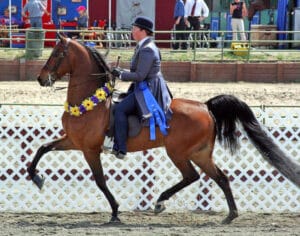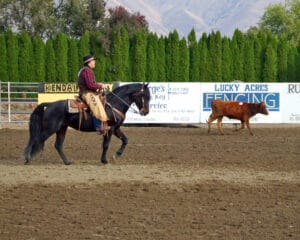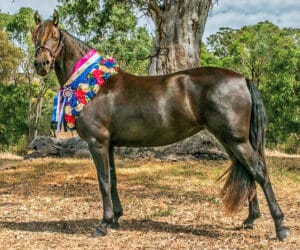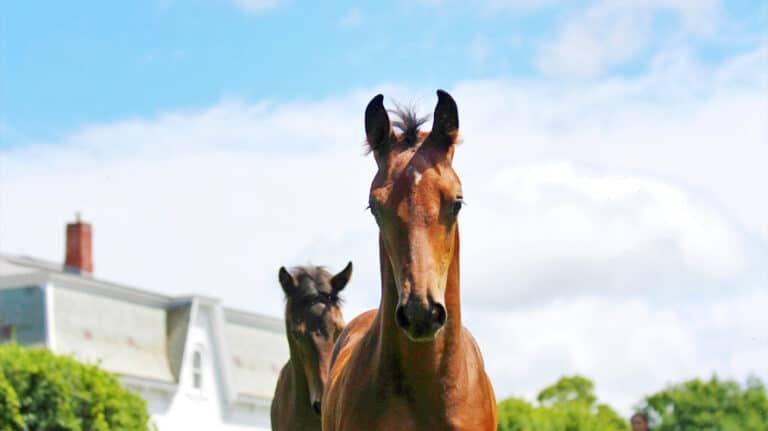A legendary American breed, the Morgan is versatile, fun, and athletic, writes MATHILDE GREGOIRE.
The Morgan is loved by Americans and many equestrians worldwide. A great sport, show, and western pleasure horse, the Morgan is wonderful under saddle and has an exceptional character.
Back in time
Few breeds can be traced back to a single horse, but for America’s beloved Morgan, it all began in 1789 with the birth in Massachusetts of a bay colt named Figure. Some believe the young horse was given to his owner Justin Morgan to settle a debt. Although relatively short, standing at 14hh, Figure possessed exceptional strength and speed. Used for farm work, plowing and pulling carriages, he also competed in many races where he regularly outperformed the competition.
While his origins remain unknown, it is thought that Figure may have come from Welsh Cob, Arabian and Thoroughbred bloodlines. Later known as ‘Justin Morgan’s horse’, he was recognised for passing his legendary traits on to his offspring and subsequently down through many generations. His outstanding features and capabilities would eventually become the hallmarks of the Morgan breed.

Saddle Seat riding, a popular show event for Morgan’s in the U.S.
In 1909, the Morgan Horse Club was founded with the aim of preserving and promoting the breed. It was later renamed the American Morgan Horse Association (AMHA) in 1971. As the Morgan’s popularity grew the association began to extend their scope and responsibilities in the interests of the breed. Today, over 90,000 Morgans are registered with the organisation.
The breed gained mainstream popularity in America and around the world following the production of Walt Disney’s movie Justin Morgan Had a Horse. Released in 1972 and based on the novel by Marguerite Henry, the movie follows the story of the first Morgan colt as the founding sire of one of the most versatile breeds in the world.
Versatile and willing
Morgans are known for their great versatility, stamina, and willingness to learn. They make an excellent pleasure riding horse that also performs exceptionally well as a stock horse. With a high-held neck and high carriage, Morgans stand on average between 14.1 to 15.2hh. Their heads are well defined, their ears short, and their eyes wide and expressive. They possess a generous throatlatch, which allows for good lateral flexion at the poll, sturdy legs with powerful hindquarters, a strong chest, and a short back.
With a thick mane and flowing tail, their most common coat colours are bay, chestnut, and black. However, the official breed registry recognises a wide range of colors, including grays, palominos, and buckskins.

Morgan stallion Cream Ridge Marty, owned by Cary Newman, competing in a Ranch Horse event.
The AMHA maintains very specific judging criteria for the confirmation standards deemed to be acceptable. It also lists four different ‘families’ within the breed: Brunk, Lippitt, Government, and Working Western, each with their own set of characteristics. With 1,000 horses registered worldwide, the Lippitt is by far the least common family subset.
While versatility is considered to be the breed’s hallmark, perhaps one of the Morgan’s best loved characteristics is their friendly and gentle nature. The AMHA’s slogan ‘The Horse that Chooses You’ reflects the breed’s affinity with humans and its aptitude as a wonderful family horse. The Morgan’s kind character has also made them popular for therapeutic riding programs.
State honours
Today, the Morgan Horse has the honour of being the official State Animal of Vermont and of Massachusetts. The University of Vermont established the Morgan Horse Farm, which is home to the oldest breeding herd in the world. The institution, which hosts a number of educational and history programs, is open to the public and can be visited from May through October each year.
One of the biggest events for the Morgan, the Annual Grand National & World Championship Morgan Horse Show is held every October in Oklahoma City. The event showcases the breed’s versatility in a week-long competition. Covering nearly all equestrian disciplines, from dressage, in-hand, reining, and western pleasure, to English and western trail classes, jumping, and carriage driving, the Morgan shines in them all.

Wildu Mandaawi Stud’s 2yo filly Wildu Niamh, winner Supreme Pure Bred at the 2019 Australian National Morgan Horse Show (Image by Penny Heighes).
The Morgan in Australia
As the Morgan’s popularity grew in the U.S., interest in the breed spread worldwide – and Australia is not indifferent to this horse’s many talents. The first Morgans were brought to Australia in the 1800s to improve trotter bloodlines.
However, the importation of Morgan breeding stock didn’t begin until 1974. Initially, a stallion and two mares were brought from the U.S. Additional horses were imported from the U.S. and Canada over the following years, creating a wider genetic pool.
The Morgan Horse Association of Australia, established in 1990, currently registers over 650 pure bred and 670 part bred Morgans, many of which are competing in a variety of disciplines at a national level, including dressage, jumping, endurance, carriage driving and showing.
Interested to know more? Visit the American Morgan Horse Association, the Morgan Horse Association of Australia, and the Morgan Horse Farm.
Feature Image: Foals at the University of Vermont‘s Morgan Horse Farm.



